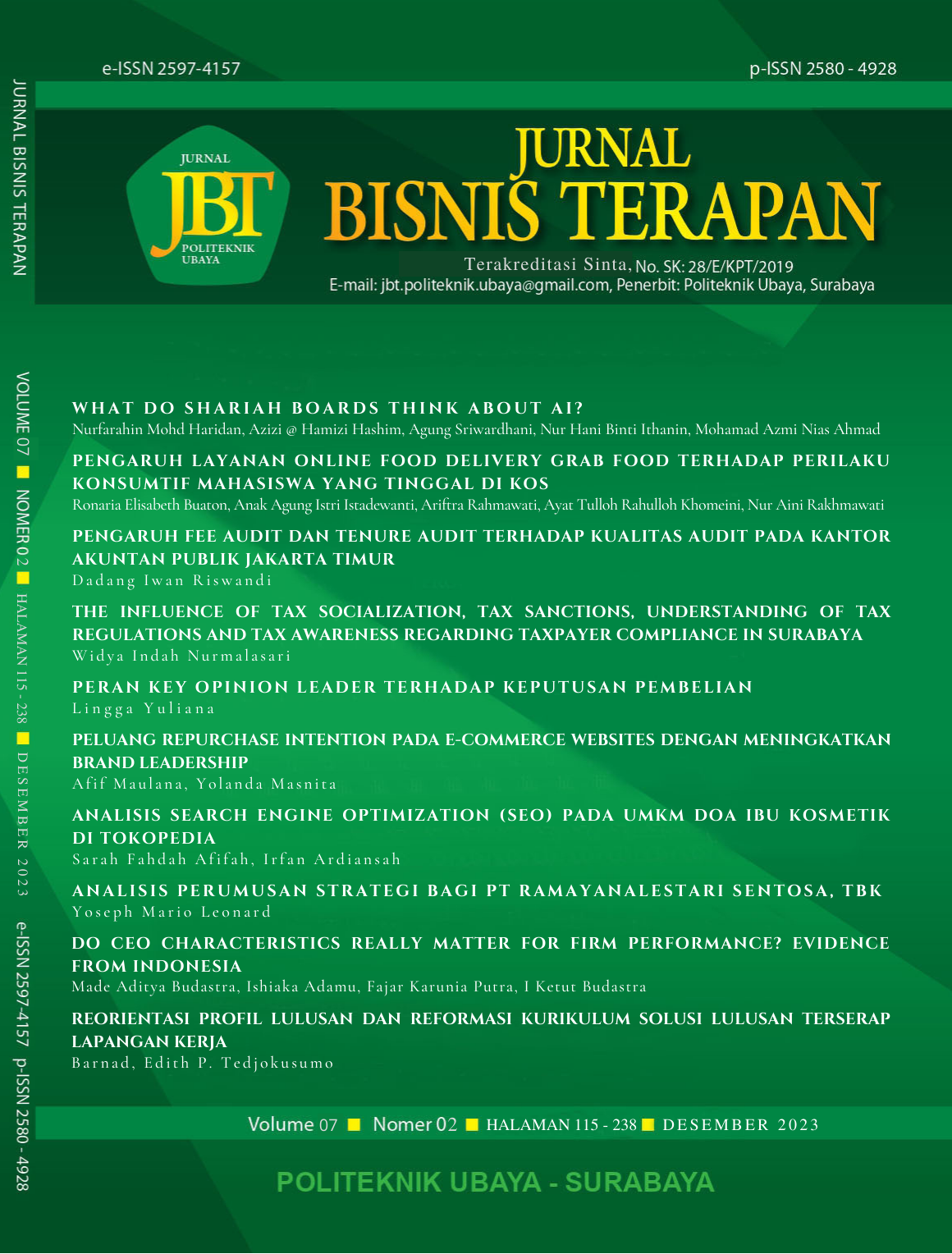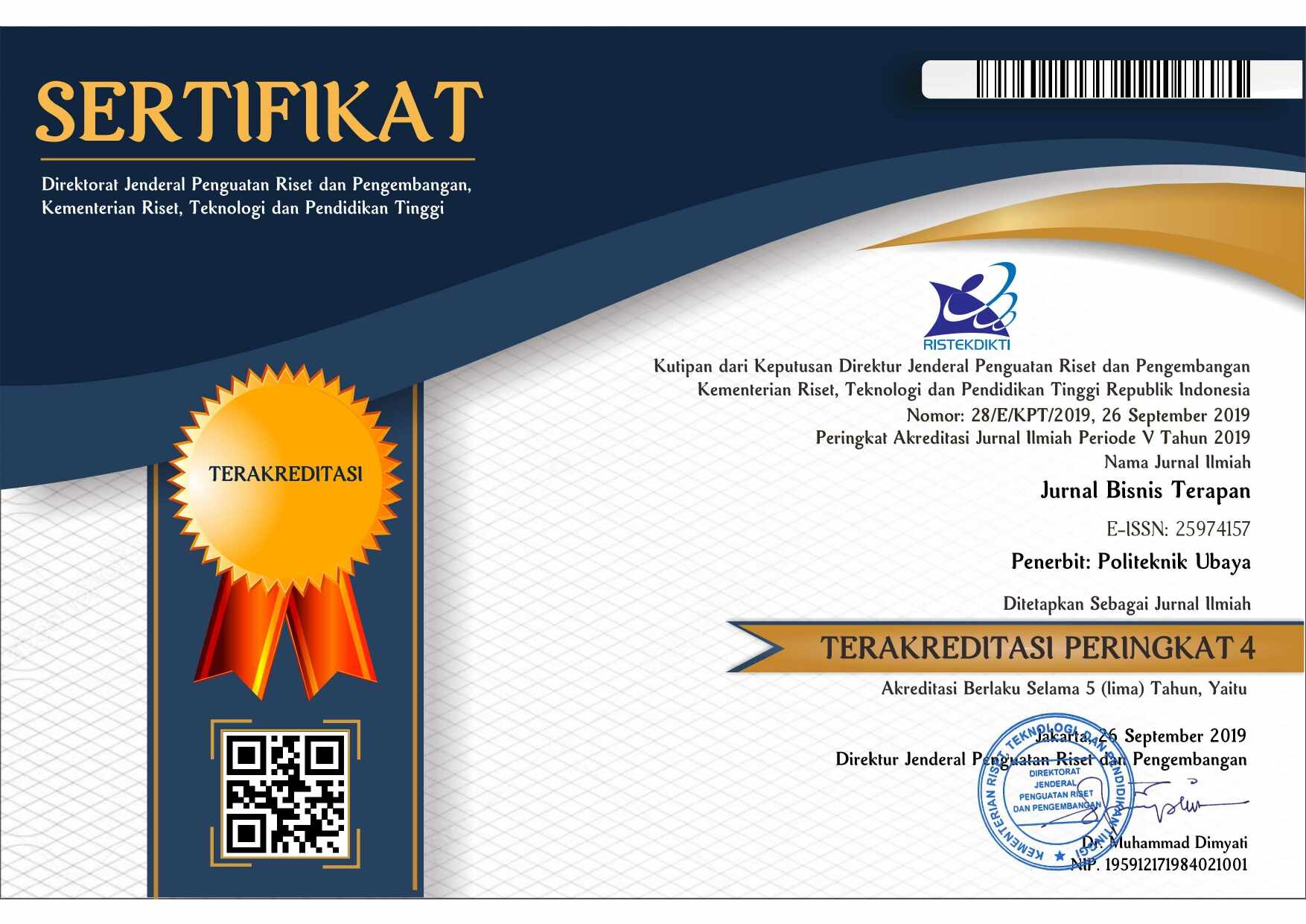DO CEO CHARACTERISTICS REALLY MATTER FOR FIRM PERFORMANCE? EVIDENCE FROM INDONESIA
 Abstract Views:
561 times
Abstract Views:
561 times
 PDF Downloads:
519 times
PDF Downloads:
519 times
Abstract
The Upper Echelon Theory explains that CEOs with certain characteristics are believed to influence firm results because the CEO plays an important role in the firm as the final decision maker. Thus, this raises the question of how important CEO characteristics are in explaining firm performance, or specifically does it matter or not. Addressing these gaps, this study aims to empirically prove the effect of CEO characteristics on firm performance. CEO characteristics in this study are proxied by tenure and gender. The data analysis technique used is Multiple Linear Regression. Based on an analysis of 102 samples of property and real estate sector companies from 2017-2019 on the IDX, we find that CEO tenure positively affects firm performance, and CEO Gender negatively affects firm performance. These results suggest that the Upper Echelon Theory is still a relevant theory for explaining the importance of top management characteristics in understanding organizational outcomes. Furthermore, companies should consider the characteristics of their CEO because it reflects the organizational outcomes.
Downloads
References
Altarawneh, M., Shafie, R., & Ishak, R. (2020). CEO characteristics: A literature review and future directions. Academy of Strategic Management Journal, 19(1), 1–10.
Boling, J. R., Pieper, T. ., & and Covin, J. . (2015). CEO tenure and entrepreneurial orientation within family and nonfamily firms. Entrepreneurship: Theory and Practice, 40(4), 891–913. https://doi.org/https://doi.org/10.1111/etap.12150
Budastra, M. A., Lukman Effendy, Robith Hudaya, & I Ketut Budastra. (2022). Reaksi Pasar Modal Indonesia Terhadap Pengumuman Reshuffle Kabinet Indonesia Maju Jilid I Dan Ii. Jurnal Bisnis Terapan, 6(1), 43–52. https://doi.org/10.24123/jbt.v6i1.4792
Faccio, M., Marchica, M. T., & Mura, R. (2016). CEO gender, corporate risk-taking, and the efficiency of capital allocation. Journal of Corporate Finance, 39, 193–209. https://doi.org/10.1016/j.jcorpfin.2016.02.008
Fauzi, H., Svensson, G., & Rahman, A. A. (2010). “Triple bottom line” as “sustainable corporate performance”: A proposition for the future. Sustainability, 2(5), 1345–1360. https://doi.org/10.3390/su2051345
Geno, M. R. P., Nuradmanta, R. W., & Firmansyah, A. (2020). Return Saham Perusahaan Subsektor Properti Dan Real Estate Di Indonesia: Rasio Likuiditas, Rasio Solvabilitas, Degree of Leverage. Moneter: Jurnal Keuangan Dan Perbankan, 8(2), 65. https://doi.org/10.32832/moneter.v8i2.4057
Hambrick, D. C., & Mason, P. A. (1984). Upper Echelons: The Organization as a Reflection of Its Top Manager. Management, 9(2), 193–206. http://www.jstor.org/stable/258434
Hazarika, S., Karpoff, J. M., & Nahata, R. (2012). Internal corporate governance, CEO turnover, and earnings management. Journal of Financial Economics, 104(1), 44–69. https://doi.org/10.1016/j.jfineco.2011.10.011
Jadiyappa, N., Jyothi, P., Sireesha, B., & Hickman, L. E. E. (2019). CEO Gender, Firm Performance, and Agency Costs: Evidence from India. Journal of Economic Studies, 46(2), 482–495.
Jamil, H. H., & Utami, E. D. (2016). Analisis Investasi Saham Subsektor Properti Dan Real Estate Di Indonesia. Cices, 2(1), 32–41. https://doi.org/10.33050/cices.v2i1.195
Kaur, R., & Singh, B. (2019). Do CEO characteristics explain firm performance in India? Journal of Strategy and Management, 12(3), 409–426. https://doi.rg/10.1108/JSMA-02-2019-0027
Liu, C., & Jiang, H. (2020). Impact of CEO characteristics on firm performance: evidence from China listed firms. Applied Economics Letters, 27(14), 1–5. https://doi.org/10.1080/13504851.2019.1607965
Llorens, M. C. R., García-Meca, E., & Duréndez, A. (2017). Influence of CEO characteristics in family firms internationalization. International Business Review, 26(4), 786–799. https://doi.org/10.1016/j.ibusrev.2017.01.007
Mbekomize, C. J., Chatibura, D. M., & Baliyan, P. S. (2021). CEO Characteristics and Firm Performance: Evidence from Tourism and Financial Firms Listed on Botswana Stock Exchange. International Journal of Business, Economics and Management, 8(6), 419–430. https://doi.org/10.18488/journal.62.2021.86.419.430
Naseem, M. A., Lin, J., Rehman, R. ur, Ahmad, M. I., & Ali, R. (2019). Does capital structure mediate the link between CEO characteristics and firm performance? Management Decision, 58(1), 164–181. https://doi.org/10.1108/MD-05-2018-0594
Peni, E. (2012). CEO and Chairperson characteristics and firm performance. Journal of Management and Governance, 18(1), 185–205. https://doi.org/10.1007/s10997-012-9224-7
Saidu, S. (2019). CEO characteristics and firm performance: focus on origin, education and ownership. Journal of Global Entrepreneurship Research, 9(1), 1–15. https://doi.org/10.1186/s40497-019-0153-7
Saleh, M. W. A., Shurafa, R., Shukeri, S. N., Nour, A. I., & Maigosh, Z. S. (2020). The effect of board multiple directorships and CEO characteristics on firm performance: evidence from Palestine. Journal of Accounting in Emerging Economies, 10(4), 637–654. https://doi.org/10.1108/JAEE-12-2019-0231
Setiawan, R., & Gestanti, L. (2022). Ceo Characteristics, Firm Policy, and Firm Performance. International Journal of Business and Society, 23(1), 371–389. https://doi.org/10.33736/ijbs.4620.2022
Singhathep, T., & Pholphirul, P. (2015). Female CEOs, Firm Performance, and Firm Development: Evidence from Thai Manufacturers. Gender, Technology and Development, 19(3), 320–345. https://doi.org/10.1177/0971852415596865
Tjahjadi, B., Soewarno, N., Nadyaningrum, V., & Aminy, A. (2020). Human capital readiness and global market orientation in Indonesian Micro-, Small- and-Medium-sized Enterprises business performance. International Journal of Productivity and Performance Management, 71(1), 79–99. https://doi.org/10.1108/IJPPM-04-2020-0181
Ventresca, M. J., & Mohr, J. W. (2017). Archival Research Methods. The Blackwell Companion to Organizations. https://doi.org/10.1111/b.9780631216940.2005.00044.x
Vintila, G., Onofrei, M., & Gherghina, S. C. (2015). The Effects of Corporate Board and CEO Characteristics on Firm Value: Empirical Evidence from Listed Companies on the Bucharest Stock Exchange. Emerging Markets Finance and Trade, 51(6), 1244–1260. https://doi.org/10.1080/1540496X.2015.1073518
Zhang, Y., & Wiersema, M. F. (2009). The Effect of Firm Compensation Structures on the Mobility and Entrepreneurship of Extreme Performers. Strategic Management Journal, 30, 693–710. https://doi.org/10.1002/smj


This work is licensed under a Creative Commons Attribution-NonCommercial-ShareAlike 4.0 International License.

Ciptaan disebarluaskan di bawah Lisensi Creative Commons Atribusi-NonKomersial-BerbagiSerupa 4.0 Internasional.
-
Articles published in Jurnal Bisnis Terapan are licensed under a Creative Commons Attribution-NonCommercial-ShareAlike 4.0 International (CC BY-NC-SA 4.0) license, which permits anyone to copy, transform, or redistribute articles for any lawful purpose in any medium, provided appropriate credit is given to the original author(s) and Jurnal Bisnis Terapan is recognized as its original publisher. A link to this license should also be provided. Any derivative work of an article published in Jurnal Bisnis Terapan must also be shared under the same (or compatible) license.
-
Both copyright and publishing rights on articles are retained by the respective author(s), without restrictions. Only a non-exclusive license is granted to Jurnal Bisnis Terapan to publish the article and identify itself as its original publisher.

 DOI:
DOI:






